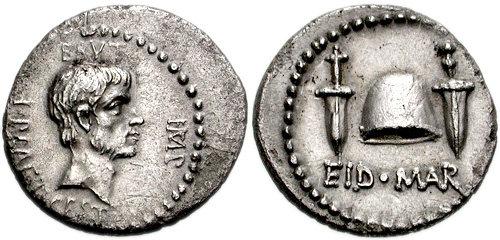|
Tutia Gens
The gens Tutia was an obscure plebeian family at ancient Rome. Only a few members of this gens are mentioned by Roman writers, but a number of others are known from inscriptions. Origin The earliest known Tutii came from the ancient city of Praeneste in Latium. Their nomen is probably derived from the cognomen ''Tutus'', meaning "safe", and belonging to a class of surnames originally derived from the supposed character of the bearer. A less likely source is the Oscan word ''touto'', referring to a people, since the Praenestini were Latins, although Chase lists both ''Toutius'' and ''Tutius'' as gentilicia of apparently Oscan origin, based on ''touto''. Praenomina The Tutii used a variety of common praenomina, including ''Gaius'', '' Lucius'', ''Marcus'', '' Publius'', ''Quintus'', ''Sextus'', and ''Titus''. From a filiation, we know that they also used the less-common '' Manius''. Two of the early inscriptions of this gens provide examples of the feminine praenomina ''Maio' ... [...More Info...] [...Related Items...] OR: [Wikipedia] [Google] [Baidu] |
Plebeian
In ancient Rome, the plebeians (also called plebs) were the general body of free Roman citizens who were not patricians, as determined by the census, or in other words "commoners". Both classes were hereditary. Etymology The precise origins of the group and the term are unclear, but may be related to the Greek, ''plēthos'', meaning masses. In Latin, the word is a singular collective noun, and its genitive is . Plebeians were not a monolithic social class. Those who resided in the city and were part of the four urban tribes are sometimes called the , while those who lived in the country and were part of the 31 smaller rural tribes are sometimes differentiated by using the label . ( List of Roman tribes) In ancient Rome In the annalistic tradition of Livy and Dionysius, the distinction between patricians and plebeians was as old as Rome itself, instituted by Romulus' appointment of the first hundred senators, whose descendants became the patriciate. Modern hypotheses d ... [...More Info...] [...Related Items...] OR: [Wikipedia] [Google] [Baidu] |
Manius (praenomen)
Manius ( , ; feminine form: ''Mania'') is a Latin , or personal name, which was used throughout the period of the Roman Republic, and well into imperial times. The name was used by both patrician and plebeian families, and gave rise to the patronymic and . Manius was originally abbreviated with an archaic five-stroke "M" (in Unicode ), which was not otherwise used in Latin. In place of this letter, the praenomen came to be abbreviated M'.''Dictionary of Greek & Roman Biography & Mythology'' Although regularly used by certain , such as the Acilii, Aemilii, Aquilii, Papirii, Sergii, and Valerii, Manius was not used by the majority of families, and was never particularly common. Between ten and twelve other praenomina were used more frequently. It became less common during the period of the Roman Empire, eventually falling out of use. Origin and meaning of the name The Roman scholar Sextus Pompeius Festus Sextus Pompeius Festus, usually known simply as Festus, was a Roman ... [...More Info...] [...Related Items...] OR: [Wikipedia] [Google] [Baidu] |
Mogontiacum
Mainz () is the capital and largest city of Rhineland-Palatinate, Germany. Mainz is on the left bank of the Rhine, opposite to the place that the Main joins the Rhine. Downstream of the confluence, the Rhine flows to the north-west, with Mainz on the left bank, and Wiesbaden, the capital of the neighbouring state Hesse, on the right bank. Mainz is an independent city with a population of 218,578 (as of 2019) and forms part of the Frankfurt Rhine-Main Metropolitan Region. Mainz was founded by the Romans in the 1st century BC as a military fortress on the northernmost frontier of the empire and provincial capital of Germania Superior. Mainz became an important city in the 8th century AD as part of the Holy Roman Empire, capital of the Electorate of Mainz and seat of the Archbishop-Elector of Mainz, the Primate of Germany. Mainz is famous as the birthplace of Johannes Gutenberg, the inventor of a movable-type printing press, who in the early 1450s manufactured his first books ... [...More Info...] [...Related Items...] OR: [Wikipedia] [Google] [Baidu] |
Auxilia
The (, lit. "auxiliaries") were introduced as non-citizen troops attached to the citizen legions by Augustus after his reorganisation of the Imperial Roman army from 30 BC. By the 2nd century, the Auxilia contained the same number of infantry as the legions and, in addition, provided almost all of the Roman army's cavalry (especially light cavalry and archers) and more specialised troops. The ''auxilia'' thus represented three-fifths of Rome's regular land forces at that time. Like their legionary counterparts, auxiliary recruits were mostly volunteers, not conscripts. The Auxilia were mainly recruited from the '' peregrini'', free provincial subjects who did not hold Roman citizenship and constituted the vast majority of the population in the 1st and 2nd centuries (c. 90% in the early 1st century). In contrast to the legions, which only admitted Roman citizens, members of the Auxilia could be recruited from territories outside of Roman control. Reliance on the vario ... [...More Info...] [...Related Items...] OR: [Wikipedia] [Google] [Baidu] |
Cohors IV Thracum
A cohort (from the Latin ''cohors'', plural ''cohortes'', see wikt:cohors for full inflection table) was a standard tactical military unit of a Roman legion. Although the standard size changed with time and situation, it was generally composed of 480 soldiers. A cohort is considered to be the equivalent of a modern military battalion. The cohort replaced the '' maniple'' following the reforms attributed to Gaius Marius in 107 BC. Shortly after the military reforms of Marius, and until the middle of the third century AD, ten cohorts (about 5,000 men total) made up a legion. Cohorts were named "first cohort,” "second cohort," etc. The first cohort consisted of experienced legionaries, while the legionaries in the tenth cohort were less experienced. Legionary cohort A legionary cohort of the early empire consisted of six ''centuriae'', or centuries, each consisting of 80 legionaries, for a total of 480 legionaries. Prior to the Marian reforms, each ''centuria'' consisted of 100 ... [...More Info...] [...Related Items...] OR: [Wikipedia] [Google] [Baidu] |
Equites
The ''equites'' (; literally "horse-" or "cavalrymen", though sometimes referred to as "knights" in English) constituted the second of the property-based classes of ancient Rome, ranking below the senatorial class. A member of the equestrian order was known as an ''eques'' (). Description During the Roman kingdom and the first century of the Roman Republic, legionary cavalry was recruited exclusively from the ranks of the patricians, who were expected to provide six '' centuriae'' of cavalry (300 horses for each consular legion). Around 400BC, 12 more ''centuriae'' of cavalry were established and these included non-patricians (plebeians). Around 300 BC the Samnite Wars obliged Rome to double the normal annual military levy from two to four legions, doubling the cavalry levy from 600 to 1,200 horses. Legionary cavalry started to recruit wealthier citizens from outside the 18 ''centuriae''. These new recruits came from the first class of commoners in the Centuriate Assembly or ... [...More Info...] [...Related Items...] OR: [Wikipedia] [Google] [Baidu] |
Campania
(man), it, Campana (woman) , population_note = , population_blank1_title = , population_blank1 = , demographics_type1 = , demographics1_footnotes = , demographics1_title1 = , demographics1_info1 = , demographics1_title2 = , demographics1_info2 = , demographics1_title3 = , demographics1_info3 = , timezone1 = CET , utc_offset1 = +1 , timezone1_DST = CEST , utc_offset1_DST = +2 , postal_code_type = , postal_code = , area_code_type = ISO 3166 code , area_code = IT-72 , blank_name_sec1 = GDP (nominal) , blank_info_sec1 = €108 billion (2018) , blank1_name_sec1 = GDP per capita , blank1_info_sec1 = €18,600 (2018) , blank2_name_sec1 = HDI (2018) , blank2_info_sec1 = 0.845 · 19th of 21 , blank_name_sec2 = NUTS Region , blank_info_sec2 = ITF , website ... [...More Info...] [...Related Items...] OR: [Wikipedia] [Google] [Baidu] |
Pompeii
Pompeii (, ) was an ancient city located in what is now the ''comune'' of Pompei near Naples in the Campania region of Italy. Pompeii, along with Herculaneum and many villas in the surrounding area (e.g. at Boscoreale, Stabiae), was buried under of volcanic ash and pumice in the Eruption of Mount Vesuvius in 79 AD. Largely preserved under the ash, the excavated city offered a unique snapshot of Roman life, frozen at the moment it was buried, although much of the detailed evidence of the everyday life of its inhabitants was lost in the excavations. It was a wealthy town, with a population of ca. 11,000 in AD 79, enjoying many fine public buildings and luxurious private houses with lavish decorations, furnishings and works of art which were the main attractions for the early excavators. Organic remains, including wooden objects and human bodies, were interred in the ash. Over time, they decayed, leaving voids that archaeologists found could be used as moulds to make plast ... [...More Info...] [...Related Items...] OR: [Wikipedia] [Google] [Baidu] |
Second Triumvirate
The Second Triumvirate was an extraordinary commission and magistracy created for Mark Antony, Marcus Aemilius Lepidus, and Octavian to give them practically absolute power. It was formally constituted by law on 27 November 43 BC with a term of five years; it was renewed in 37 BC for another five years before expiring in 32 BC. Constituted by the '' lex Titia'', the triumvirs were given broad powers to make or repeal legislation, issue judicial punishments without due process or right of appeal, and appoint all other magistrates. The triumvirs also split the Roman world into three sets of provinces. The triumvirate, formed in the aftermath of a conflict between Antony and the senate, emerged as a force to reassert Caesarian control over the western provinces and wage war on the ''liberatores'' led by the men who assassinated Julius Caesar. After proscriptions, purging the senatorial and equestrian orders, and a brutal civil war, the ''liberatores'' were def ... [...More Info...] [...Related Items...] OR: [Wikipedia] [Google] [Baidu] |
Proscription
Proscription ( la, proscriptio) is, in current usage, a 'decree of condemnation to death or banishment' (''Oxford English Dictionary'') and can be used in a political context to refer to state-approved murder or banishment. The term originated in Ancient Rome, where it included public identification and official condemnation of declared enemies of the state and it often involved confiscation of property. Its usage has been significantly widened to describe governmental and political sanctions of varying severity on individuals and classes of people who have fallen into disfavor, from the ''en masse'' suppression of adherents of unorthodox ideologies to the suppression of political rivals or personal enemies. In addition to its recurrences during the various phases of the Roman Republic, it has become a standard term to label: * The suppression of Royalists after Oliver Cromwell's decisive defeat of Charles II at the Battle of Worcester in 1651 (see image) * The curbing of ... [...More Info...] [...Related Items...] OR: [Wikipedia] [Google] [Baidu] |
Titus Pomponius Atticus
Titus Pomponius Atticus (November 110 BC – 31 March 32 BC; later named Quintus Caecilius Pomponianus Atticus) was a Roman editor, banker, and patron of letters, best known for his correspondence and close friendship with prominent Roman statesman Marcus Tullius Cicero. Atticus was from a wealthy Roman family of the equestrian class (lower aristocratic non-ruling class) and from the Pomponia gens. A close friend since childhood, Cicero dedicated his treatise, ' (), to Atticus. Their correspondence, often written in subtle code to disguise their political observations, is preserved in ' (''Letters to Atticus'') compiled by Tiro, Cicero's slave (later his freedman) and personal secretary. Biography Early life Born Titus Pomponius in Rome , Atticus descended from a family of equestrian rank and was the son of Titus Pomponius and Caecilia. He had a sister named Pomponia. Growing up, he studied and developed close friendships with Cicero, Lucius Manlius Torquatus, and Gaius ... [...More Info...] [...Related Items...] OR: [Wikipedia] [Google] [Baidu] |
Cicero
Marcus Tullius Cicero ( ; ; 3 January 106 BC – 7 December 43 BC) was a Roman statesman, lawyer, scholar, philosopher, and academic skeptic, who tried to uphold optimate principles during the political crises that led to the establishment of the Roman Empire. His extensive writings include treatises on rhetoric, philosophy and politics, and he is considered one of Rome's greatest orators and prose stylists. He came from a wealthy municipal family of the Roman equestrian order, and served as consul in 63 BC. His influence on the Latin language was immense. He wrote more than three-quarters of extant Latin literature that is known to have existed in his lifetime, and it has been said that subsequent prose was either a reaction against or a return to his style, not only in Latin but in European languages up to the 19th century. Cicero introduced into Latin the arguments of the chief schools of Hellenistic philosophy and created a Latin philosophical voc ... [...More Info...] [...Related Items...] OR: [Wikipedia] [Google] [Baidu] |







